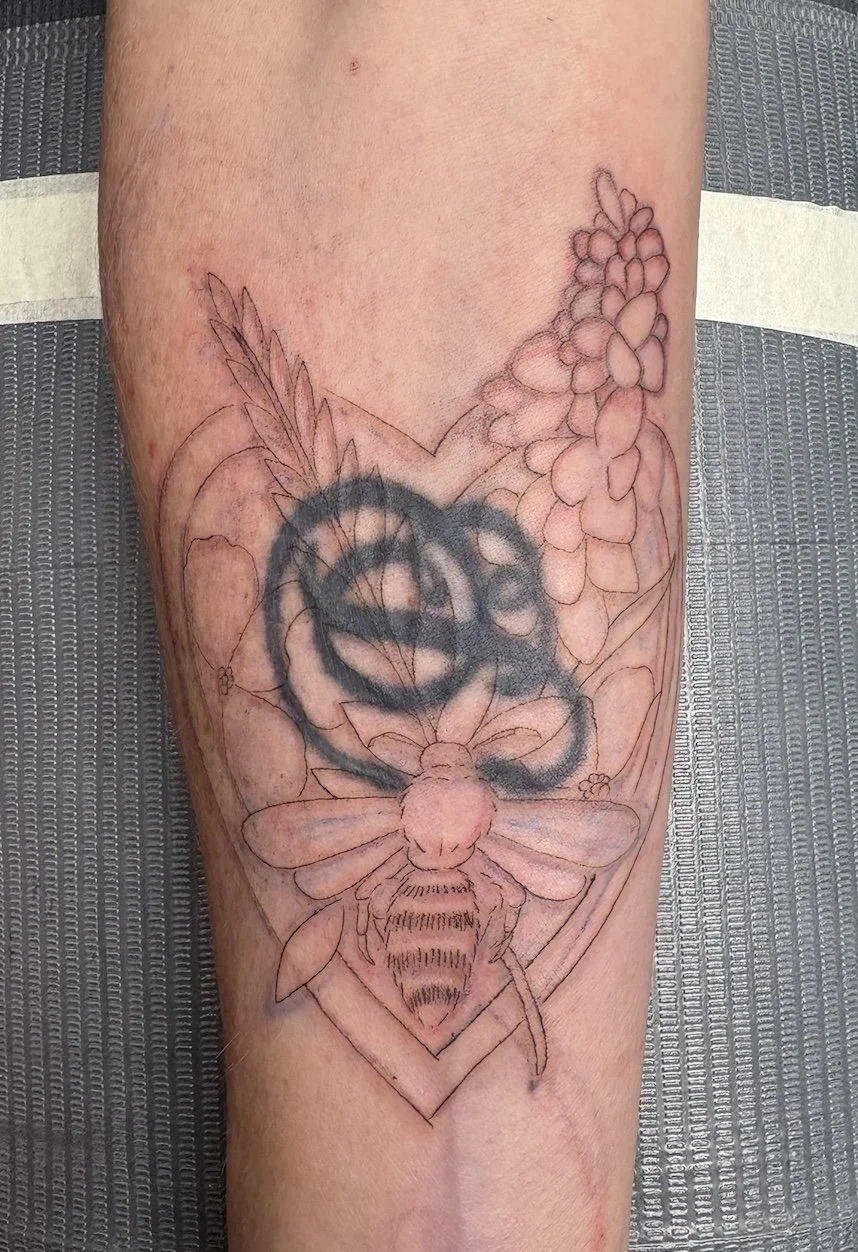Color Cover ups explained
The Original Tattoo – A Starting Point for Transformation
This first photo shows the closest look at the original tattoo before its transformation. When working with existing tattoos, the biggest challenge is understanding what lies beneath—both in pigment density and placement. Every old tattoo has a “value” (lightness or darkness) that affects what new colors can successfully sit on top of it.
Color tattoo inks are transparent, meaning they don’t completely mask what’s underneath. That’s why understanding value and tone is critical when creating a cover-up that feels seamless and natural on the skin.
Drawing Directly on the Skin – Shaping the Vision
Because the original tattoo had very tight margins, it was more effective to draw the new design directly on the client’s arm rather than on a stencil. This allowed the artwork to evolve organically, following her natural contours and creative direction in real time.
Freehand drawing ensures that each element aligns perfectly with the body’s shape and the existing ink below. It’s an intuitive, collaborative process that helps the tattoo move with the client, not just rest on their skin.
Completed Tattoo – A Balance of Tone and Value
Here we see the finished tattoo in all its layered color harmony. Each hue was carefully chosen to complement both the old tattoo’s base tones and the client’s individual skin undertones.
Because tattoo inks are translucent, color theory and value control play a vital role—lighter colors must contrast properly with darker under layers to maintain brightness, while richer hues provide the coverage and depth needed to disguise the original piece.
It’s important to remember in coverups you can tint the existing pigment to conceal it. But the values can only be shifted slightly. Which is why it’s so important to build the coverup tattoo into the design the client prefers. In this example we can see how we laid this tattoo out based on preference for the client to conceal a black tattoo under.
Alternate View – Depth and Dimension in Color
This second angle of the finished tattoo highlights how tonal balance and value gradients give the artwork its three-dimensional feel. The interplay of warm and cool colors creates visual movement, while carefully layered shading gives the illusion of light and form without oversaturating the skin.
This photo showcases how thoughtful color transitions, when aligned with a client’s undertone and healed appearance, create a tattoo that feels alive on the skin.
It helps this client was creatively flexible with the subject matter with some things that were primary objects that needed to be in the design. Concealing is the main name of the game with coverups. This is a great example of what is possible in one tattoo session.
Tone and Skin Harmony – The Science Behind Color Selection
Every client’s skin has unique undertones—cool, warm, or neutral—that influence how color tattoos heal. Inks don’t cover skin like paint; they live beneath it, and the skin’s hue acts as a natural filter.
By selecting tones that harmonize with the client’s complexion, we ensure the healed tattoo looks balanced, vibrant, and long-lasting. This is why collaborative color testing before large cover-ups is so valuable—it ensures each pigment reads correctly once healed.
During the drawing process I was keen on asking my client for her preference of colors so that I could lay the design out with the final product in mind. We engaged in a collaborative tattoo process to bring the image together that would A) work for a coverup tattoo, B) give her the colors she longed for, C) have the durability to cover the original tattoo effectively.
Before and After – A Study in Color Evolution
The final comparison image brings the full transformation to life: the original tattoo, the drawn-on planning, and the vibrant completed design. This progression illustrates how understanding tone, value, and color transparency can turn a limited cover-up area into a masterpiece.
Every successful color cover-up depends on precision, planning, and artistry—layering tones, respecting undertones, and trusting the science of pigment.
I have lost the records of this client, and I am seeking this client. So if you know or have seen this client please tell her I am looking for her. I want healed photos.
IF you are seeking a coverup or a transformation for a tattoo: Click here to book a tattoo chat to ask some questions.







